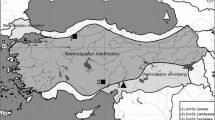Abstract
Chromosomes of Didelphis albiventris, D. marsupialis, Philander opossum and Lutreolina crassicaudata, four species of marsupials with very similar karyotypes and 2n=22 were studied. All the chromosomes were acrocentrics except the X in L. crassicaudata, which is a metacentric.
The G-band patterns of these species are similar but the distribution of constitutive heterochromatin differs among them as shown by C-banding. The hypothesis that the X in L. crassicaudata might be an isochromosome derived from the acrocentric X in the other species is discarded since G-and C-banding patterns differ in the two arms.
In D. marsupialis the Ag-NORs are terminal and located in both arms of one pair and in the long arms of two pairs of medium-sized autosomes. In P. opossum the NOR-bearing chromosomes could be precisely identified through simultaneous silver staining and G-banding. The Ag-NORs are terminal and located at the short arm of pair 5 and the long arm of pair 7.
Similar content being viewed by others
References
Baverstock, P. R., Watts, C. H. S. & Hogarth, J. T., 1977. Chromosome evolution in Australian rodents. I. The Pseudomyinae, the Hydromyinae and the Uromys/Melomys group. Chromosoma 61: 95–125.
Bloom, S. E. & Goodpasture, C., 1976. An improved technique for selective silver staining of nucleolar organizer regions in human chromosomes. Hum. Genet. 34: 199–206.
Buckland, R. A. & Evans, H. J., 1978. Cytogenetic aspects of phylogeny in the Bovidae. I. C-banding. Cytogenet. Cell Genet. 21: 64–71.
Cureuru-Giordano, F. M., Weed, R. G. & Jenkins, E. C., 1974. Banding analysis of the chromosomes of Marmosa mitis (Murine opossum). Can. J. Genet. Cytol. 16: 31–38.
Fornandez-Donoso, R., Barrios, S. & Pineheira, J., 1979. Position of the nucleolus within the nuclei of pachytene spermatocytes of Dromiciops australis and Marmosa elegans (Didelphoidea-Marsupialia). Experientia 35: 1021–1023.
Goodpasture, C. & Bloom, S. E., 1975. Visualization of the nucleolar organizer regions in mammalian chromosomes using silver staining. Chromosoma 53: 37–50.
Hayman, D. L. & Martin, P. G., 1969. Cytogenetics of Marsupials. In: Comparative mammalian cytogenetics, pp. 191–217. Ed. K.Benirschke. Springer-verlag, New York.
Hayman, D. L., 1977. Chromosome number-constancy and variation, In: The biology of Marsupials, pp. 27–48. Eds B. Stonehouse & D. Gilmore. University Park Press.
Marcarello, J. T., Warner, J. W. & Baker, R. J., 1974. A chromosome banding analysis of the mechanisms involved in the karyological divergence of Neotoma phenax (Merriam) and Neotoma micropus Baird. J. Mammal., 55: 831–834.
Miller, D. A., Dev, V. G., Tantravahi, R., Miller, O. J., 1976a. Supression of human nucleolus organizer activity in mouse-human somatic hybrid cells. Expl Cell Res. 101: 235–243.
Miller, Q. J., Miller, D. A. Dev, V. G., Tantravahi, R. & Croce, C. M., 1976b. Expression of human and supression of mouse nucleolus organizer activity in mouse-human somatic cell hybrids. Proc. natn. Acad. Sci. U.S.A. 73: 4531–4535.
Murray, J. D., 1977. Nonrandom sex-chromosome association and constitutive heterochromatin in the brush-tailed possum, Trichosurus vulpecula (Marsuplalia Phalangeridae). Cytogenet. Cell Genet. 18: 90–96.
Murray, J. D., Sharman, G. B., McKay, G. M. & Calaky, J. H., 1980. Karyotypes, constitutive heterochromatin and taxonomy of ringtail opossum of the genus Pseudocherus (Marsupialia: Petauridae). Cytogenet. Cell Genet. 27: 73–81.
Pathak, S. & Stock, A. D., 1974. The X chromosome of mammals: karyological homology as revealed by handing technique. Genetics 78: 703–714.
Pathak, S., Hsu, T. C. & Arrighi, F. E., 1973. Chromosomos of Peromyscus (Rodentia. Cricetidae). IV. The role of heterochromatin in karyotype evolution. Cytogenet. Cell Genet. 12: 315–326.
Reig, Q. A., Gardner, A. L., Bianchi, N. O. & Patton, J. L., 1977. The chromosomes of the Didelphidae (Marsupialia) and their evolutionary significance. Biol. J. Linn. Society 9: 191–216.
Ryder, O. A., Epel, N. C. & Benirsehko, K., 1978. Chromosome banding studies of the Equidae. Cytogenet. Cell Genet. 20: 323–350.
Seabright, M., 1971. A rapid handing technique for human chromosomes. Lancet 11: 971–972.
Sharman, G. B., 1973. The chromosomes of non-cutherian Mammals. In: Cytotaxonomy and vertebrate evolution 485–530. Eds A. B.Chiarelli & F.Capanna, Academic Press, London.
Sinha, A. K., Kakati, S. & Pathak, S., 1972. Exelusive localization of C-bands within opossum sex chromosomes. Expl Cell Res. 75: 265–267.
Sinha, A. K. & Sakati, 1976. C-and G-bands of the opossum chromosomes: terminal sequences of DNA replication. Can. J. Genet. Cytol. 18: 195–205.
Sumner, A. T., 1972. A simple technique for demonstrating centromorie heterochromatin. Expl Cell Res. 75: 304–306.
Yosida, T. H., 1975. Diminution of heterochromatic C-bands in relation to the differentiation of Rattus species. Proc. Japan Acad. 51: 659–663.
Yosida, T. H. & Sagai, T., 1975. Variation of C-bands in the chromosomes of several subspecies of Rattus rattus. Chromosoma 50: 283–300.
Zunkl, H. & Bernhardt, S., 1977. Combined silver stalning of the nucleolus organizing regions and Giemsa banding in human chromosomes. Hum. Genet. 37: 79–80.
Author information
Authors and Affiliations
Rights and permissions
About this article
Cite this article
Yononaga-Yassuda, Y., Kasahara, S., Souza, M.J. et al. Constitutive heterochromatin, G-bands and nucleolus-organizer regions in four species of Didelphidae (Marsupialia). Genetica 58, 71–77 (1982). https://doi.org/10.1007/BF00056006
Received:
Accepted:
Issue Date:
DOI: https://doi.org/10.1007/BF00056006




